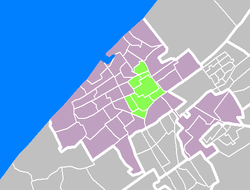
The Hague is a city and municipality of the Netherlands, situated on the west coast facing the North Sea. The Hague is the capital of the province of South Holland. The Hague is the country's administrative centre and its seat of government, and while the official capital of the Netherlands is Amsterdam, The Hague has been described as the country's de facto capital.

Scheveningen is one of the eight districts of The Hague, Netherlands, as well as a subdistrict (wijk) of that city. Scheveningen is a modern seaside resort with a long, sandy beach, an esplanade, a pier, and a lighthouse. The beach is popular for water sports such as windsurfing and kiteboarding. The harbour is used for both fishing and tourism.

Zoetermeer is a city in the Western Netherlands, in the province of South Holland. The municipality covers an area of 37.05 km2 (14.31 sq mi) of which 2.60 km2 (1.00 sq mi) is water. A small village until the late 1960s, it had 6,392 inhabitants in 1950. By 2013 this had grown to 123,328, making it the third largest population centre in the province of South Holland, after Rotterdam, The Hague and Leiden. While now a city in its own right, Zoetermeer started out as a suburb of The Hague and is still a part of the Greater The Hague urban area.
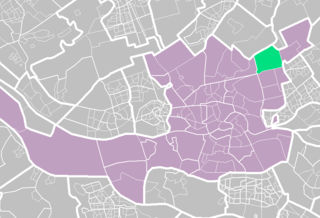
Ommoord is a neighbourhood in the former borough Prins Alexander, part of the municipality of Rotterdam, South Holland, the Netherlands. Ommoord is surrounded by the neighbourhoods Zevenkamp, Het Lage Land and Terbregge. It has around 25.000 inhabitants across 12.500 households. Ommoord shares postal codes 3068 and 3069 with Zevenkamp.

The Jordaan is a neighbourhood of the city of Amsterdam, Netherlands. It is part of the borough of Amsterdam-Centrum. The area is bordered by the Singelgracht canal and the neighbourhood of Frederik Hendrikbuurt to the west; the Prinsengracht to the east; the Brouwersgracht to the north and the Leidsegracht to the south. The former canal Rozengracht is the main traffic artery through the neighbourhood.

Den Haag Centraal is the largest railway station in the city of The Hague in South Holland, Netherlands, and with twelve tracks, the largest terminal station in the Netherlands. The railway station opened in 1973, adjacent to its predecessor: Den Haag Staatsspoor, which was subsequently demolished. It is the western terminus of the Gouda–Den Haag railway.

The city of The Hague, Netherlands, consists of eight districts, similar to boroughs. Each district is divided into subdistricts (wijken). Each of these stadsdelen has its own district office (stadsdeelkantoor), where most of the local government activity is organised. These stadsdeelkantoren make many aspects of local government more accessible to residents. The current division of The Hague into individual stadsdelen was created in 1988 by the main city government. This division of The Hague into wijken (subdistricts) and buurten (neighbourhoods) deviates from the 1953 divisions that had been known to many residents.

Benoordenhout is a neighbourhood in the Haagse Hout district of The Hague. In addition to Benoordenhout, Haagse Hout consists of the Bezuidenhout, Mariahoeve en Marlot, and Haagse Bos neighbourhoods.

Loosduinen is a former village in the Netherlands that was a municipality unto itself until 1923, when it was annexed by The Hague and subsequently became a district of the city.

Den Haag HS, an abbreviation of the original name Den Haag Hollands Spoor, is the oldest train station in The Hague, South Holland, Netherlands, located on the Amsterdam–Haarlem–Rotterdam railway. It is the second main station in The Hague and, unlike The Hague Central Station, it is not a terminus station. The name of the station is derived from the former Hollandsche IJzeren Spoorweg-Maatschappij (HIJSM) which was the first Dutch railway company.

Spoorwijk is a residential neighbourhood in the Laak district of The Hague, Netherlands. Its name, literally rail neighbourhood or track neighbourhood, originated from the fact that the area borders the Amsterdam–Haarlem–Rotterdam railway on the west. The neighbourhood has 4,161 inhabitants and covers an area of 33,3 ha.

The bombing of the Bezuidenhout took place on 3 March 1945, when the Royal Air Force mistakenly bombed the Bezuidenhout neighbourhood in the Dutch city of The Hague resulting in the death of 532 citizens.
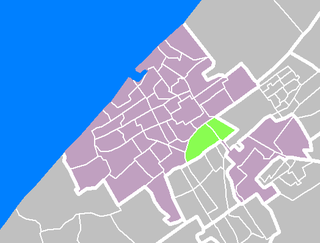
Laak is district of The Hague, Netherlands. With a population of 40,222 and an area of 4.3 square kilometres (1.7 sq mi), it is the smallest and least populous of the city's eight districts. The district is officially divided into three neighbourhoods: Laakkwartier, Spoorwijk and Binckhorst. The Hague University of Applied Sciences can be found in Laak.

The Archipelbuurt is a neighbourhood in the Centrum district of The Hague, Netherlands. It has 5,764 inhabitants and covers an area of 87.1 hectares (0.336 sq mi). Built primarily between 1860 and 1890, the neighbourhood is known for its Neo-Renaissance architecture and wide avenues and streets. Important streets in the Archipelbuurt include the Javastraat, the Surinamestraat, the Scheveningseweg, the Nassauplein and the Burgemeester De Monchyplein. A Jewish graveyard, a chapel and a former city hall of The Hague can be found in the neighbourhood. The Dutch novelist and poet Louis Couperus resided in Javastraat 17. Today, this is the Louis Couperus Museum.
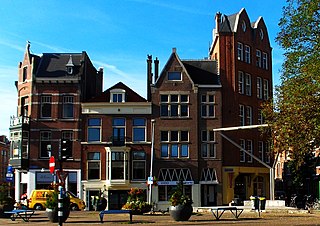
The Zeeheldenkwartier is a neighbourhood in the Centrum district of The Hague, Netherlands. It has 11,205 inhabitants and covers an area of 81.3 hectares (0.314 sq mi). It is bordered by the Carnegielaan, the Zeestraat, the Hoge Wal and the Prinsessewal to the north-east, the Veenkade to the south, the Waldeck Pyrmontkade to the south-west and the Laan van Meerdervoort to the Carnegielaan to the north. Built between 1870 and 1890, the style of the buildings differs between larger houses for important officials near the Willemspark and the Laan van Meerdervoort, and predominantly smaller houses nearer to the city centre. It has also the most Coffeeshops in town. And it has from Albert Heijn the biggest supermarket in town called “Albert Heijn XL”.
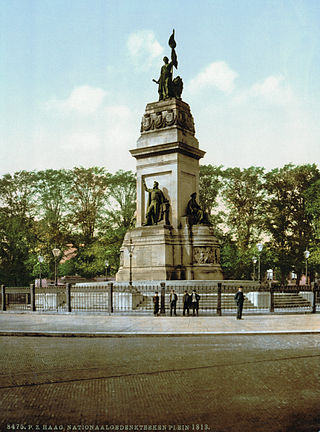
The Willemspark is a neighbourhood in the Centrum district of The Hague, Netherlands. It has 1,393 inhabitants and covers an area of 34.6 hectares (0.134 sq mi). It is bordered by the Zeestraat to the south-east, the Scheveningseveer, the Mauritskade and the Dr. Kuyperstraat to the south-east, the Prinsessegracht to the north-east and the Javastraat to the north-west. The park was originally property of king William II, but he sold the area to the municipality of The Hague in 1855, after which it became a villa park. Iconic to the neighbourhood are the Alexanderstraat and the Sophialaan that intersect on Plein 1813. This square is marked by a monument commemorating the defeat of Napoleon and the establishment of the Sovereign Principality of the United Netherlands.
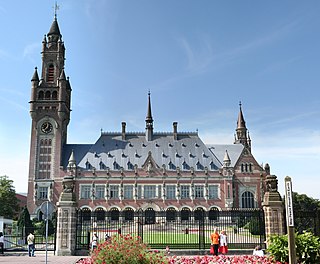
Zorgvliet is a neighbourhood in the Scheveningen district of The Hague, Netherlands. It is named after the estate of the same name, once owned by the poet and writer Jacob Cats,, later by 18th century politician Willem Bentinck van Rhoon and later again becoming the official residence of the Dutch Prime Minister. It has 377 inhabitants and covers an area of 876 hectares (3.38 sq mi). It is bordered by the Laan van Meerdervoort, the Groot Hertoginnelaan, the Stadhouderslaan, the Stadhoudersplantsoen and the Eisenhowerlaan. Zorgvliet is the location of The Hague's "international zone", which is home to the International Criminal Tribunal for the former Yugoslavia, the Organisation for the Prohibition of Chemical Weapons, Europol and the World Forum Convention Center. The Peace Palace, housing the Permanent Court of Arbitration and the International Court of Justice, is also located in Zorgvliet. Moreover, Zorgvliet is the location of the Museum Mesdag, Gemeentemuseum Den Haag and Museon.

Forepark is a business park in The Hague, Netherlands, east of the Prins Clausplein highway interchange. It was developed in the 1990s, together with the nearby residential neighbourhood Leidschenveen. Originally part of the municipality of Leidschendam, it was annexed by The Hague in 2002 and now falls under the district of Leidschenveen-Ypenburg. Since 2007, Forepark is home to Cars Jeans Stadion, the home stadium of ADO Den Haag. Since the construction of the RandstadRail network, the business park is connected to the metro line between Rotterdam and the city centre of The Hague via Forepark Station.

Houtwijk is a neighbourhood of The Hague, located in the Loosduinen district, with more than 5,000 homes. Houtwijk mainly contains a lot of new constructions that were built both in and after the 1970s and 1980s. There are also both many owner-occupied and rental properties. While officially a neighbourhood of Loosduinen, some residents consider it its own subdistrict. This is mainly because its name contains wijk which translates to "district".

The Jokinen Plan comprises two reports, drawn up by the American traffic expert David A. Jokinen, on the urban planning of two Dutch cities: for The Hague in 1962, and for Amsterdam in 1967, both set out in a brochure.
